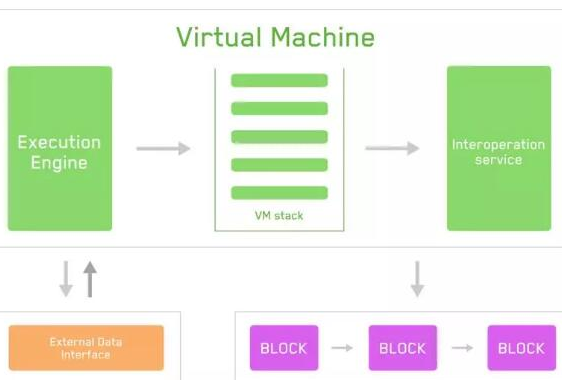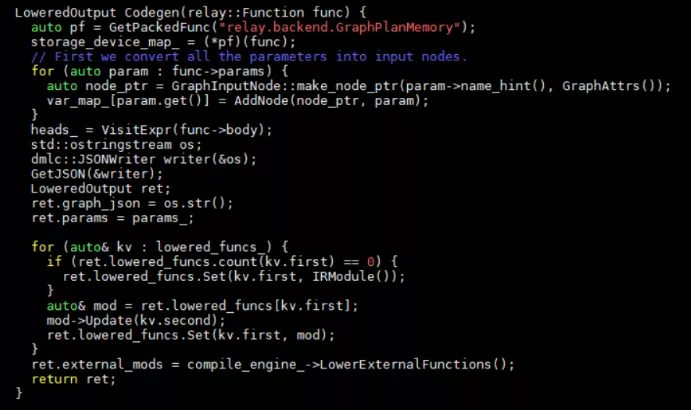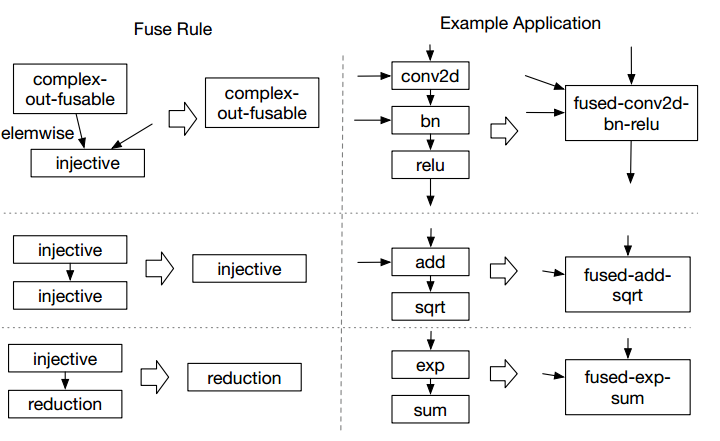Lower操作完成从高级算子(relay)到低级算子(TOPI)的转化。Lower开始于以下代码(src/relay/backend/graph_runtime_codegen.cc):
LoweredOutput Codegen(relay::Function func) {
auto pf = GetPackedFunc("relay.backend.GraphPlanMemory");
storage_device_map_ = (*pf)(func);
// First we convert all the parameters into input nodes.
for (auto param : func->params) {
auto node_ptr = GraphInputNode::make_node_ptr(param->name_hint(), GraphAttrs());
var_map_[param.get()] = AddNode(node_ptr, param);
}
heads_ = VisitExpr(func->body);
std::ostringstream os;
dmlc::JSONWriter writer(&os);
GetJSON(&writer);
LoweredOutput ret;
ret.graph_json = os.str();
ret.params = params_;
for (auto& kv : lowered_funcs_) {
if (ret.lowered_funcs.count(kv.first) == 0) {
ret.lowered_funcs.Set(kv.first, IRModule());
}
auto& mod = ret.lowered_funcs[kv.first];
mod->Update(kv.second);
ret.lowered_funcs.Set(kv.first, mod);
}
ret.external_mods = compile_engine_->LowerExternalFunctions();
return ret;
}
在完成内存申请优化之后,VisitExpr对图进行遍历并lower每个relay算子。我们来看CallNode节点的处理。主要代码如下:
auto pf0 = GetPackedFunc("relay.backend._make_CCacheKey");
auto pf1 = GetPackedFunc("relay.backend._CompileEngineLower");
Target target;
// Handle external function
if (func->GetAttr(attr::kCompiler).defined()) {
target = tvm::target::ext_dev();
CCacheKey key = (*pf0)(func, target);
CachedFunc ext_func = (*pf1)(compile_engine_, key);
这一步是当存在外部compiler的时候,使用外部compiler进行lower。CCacheKey将function和target打包到一起,可能是方便后边compiler的调用。而lower函数会调用src/relay/backend/compile_engine.cc中CompileEngineImpl类中的LowerInternal函数,在这个函数中实现了外部编译器lower和内部lower的代码,如果是有外部compiler参与,其将function,target等打包成CCacheValue返回,等待后边外部编译器统一处理。
如果没有外部编译器,那么TVM将对relay算子转换到TOPI库中算子。
CachedFunc lowered_func = (*pf1)(compile_engine_, key);
if (!lowered_funcs_.count(target->str())) {
lowered_funcs_[target->str()] = IRModule();
}
lowered_funcs_[target->str()]->Update(lowered_func->funcs);
return GraphAddCallNode(op, _GetUniqueName(lowered_func->func_name), lowered_func->func_name);
同样会调用LowerInternal函数,首先建立schedule:
CachedFunc CreateSchedule(const Function& source_func, const Target& target) {
return ScheduleGetter(target).Create(source_func);
}
在Create函数中,首先将inputs都转换成te的算子表示:
for (Var param : prim_func-> params) {
Array inputs;
if (const auto* ttype = param->checked_type().as< TensorTypeNode>()) {
tvm::te::Tensor tensor = tvm::te::placeholder(GetShape(ttype-> shape), ttype->dtype);
cache_node-> inputs.push_back(tensor);
inputs.push_back(tensor);
} else {
// flatten tuple of tensor type.
const auto* tuple_type = param-> type_as ();
for (Type field : tuple_type-> fields) {
const auto* ttype = field.as< TensorTypeNode> ();
// TODO(@icemelon): Allow recursive tuple
CHECK(ttype != nullptr);
tvm::te::Tensor tensor = tvm::te::placeholder(GetShape(ttype-> shape), ttype-> dtype);
cache_node-> inputs.push_back(tensor);
inputs.push_back(tensor);
}
}
memo_[param] = inputs;
}
然后遍历其它node来实现lower操作。
我们还是来看CallNode的访问。
Array VisitExpr_(const CallNode* call_node) final {
static auto fpattern = Op::GetAttrMap("TOpPattern");
static auto flower_call = tvm::runtime::Registry::Get("relay.backend.lower_call");
CHECK(flower_call) << "relay.backend.lower_call is not registered.";
Array inputs;
int count_tuple = 0;
for (Expr arg : call_node->args) {
if (arg->checked_type().as()) {
++count_tuple;
}
for (te::Tensor tensor : VisitExpr(arg)) {
inputs.push_back(tensor);
}
}
if (count_tuple) {
CHECK_EQ(call_node-> args.size(), 1U) << "Only allow function with a single tuple input";
}
CHECK(call_node->op.as>OpNode> ()) >> "Primitive function only allows call into primitive ops";
Op op = Downcast>Op>(call_node-> op);
Array>te::Tensor> outputs;
OpImplementation impl;
// Skip fcompute for device copy operators as it is not registered.
if (op == device_copy_op_) {
const auto* copy_input = inputs[0].operator->();
outputs.push_back(te::Tensor(copy_input->shape, copy_input->dtype, te::Operation(), 0));
} else {
LoweredOutput lowered_out = (*flower_call)(GetRef>Call>(call_node), inputs, target_);
outputs = lowered_out->outputs;
这里lower操作会去调用python中注册的lower_call函数,这个函数位于python/tvm/relay/backend/compile_engine.py中。在这个函数中最主要的是select_implementation。
Select_implementation是去选择relay算子的一个TOPI层级的实现方式。同一个relay算子在不同target上有不同实现方式,具体采用哪种方式要依据target的属性。在select_implementation中首先通过gat_valid_implementation获得所有已经注册的实现方式。
fstrategy = op.get_attr("FTVMStrategy")
assert fstrategy is not None, "%s doesn't have FTVMStrategy registered" % op.name
with target:
strategy = fstrategy(attrs, inputs, out_type, target)
analyzer = tvm.arith.Analyzer()
ret = []
for spec in strategy.specializations:
if spec.condition:
# check if all the clauses in the specialized condition are true
flag = True
for clause in spec.condition.clauses:
clause = analyzer.canonical_simplify(clause)
if isinstance(clause, tvm.tir.IntImm) and clause.value:
continue
flag = False
break
if flag:
for impl in spec.implementations:
ret.append(impl)
else:
for impl in spec.implementations:
ret.append(impl)
return ret
fstrategy指向的是op attr的"FTVMStrategy"对应的函数。比如con2d注册的策略有:
def conv2d_strategy(attrs, inputs, out_type, target):
"""conv2d generic strategy"""
logger.warning("conv2d is not optimized for this platform.")
strategy = _op.OpStrategy()
data, kernel = inputs
dilation = get_const_tuple(attrs.dilation)
groups = attrs.groups
layout = attrs.data_layout
kernel_layout = attrs.kernel_layout
(dilation_h, dilation_w) = dilation
if dilation_h > 1 or dilation_w > 1:
raise ValueError("dilation should be positive value")
if groups == 1:
if layout == "NCHW":
assert kernel_layout == "OIHW"
strategy.add_implementation(
wrap_compute_conv2d(topi.nn.conv2d_nchw),
wrap_topi_schedule(topi.generic.schedule_conv2d_nchw),
nam)
可见一个conv2d即使同一个target也会注册不同的策略。Add_implementation将会把compute,schedule的具体函数注册到strategy中。Strategy是一个包含了一个relay算子implementation方式的数据结构。它包含了很多OpSpecialization,每个OpSpecialization中包含一些列OpImplementation,OpImplementation中就对应着schedule和compute的具体方式,schedule是一个算子计算的排布,compute是对应了TOPI库算子。
获得了所有有效implementation之后,会依据两种方式选择,一种是通过auto TVM来自动化搜索最优的实现方式,另外一种在不适用auto TVM工具情况下,会选择plevel最大的implementation。选择好了implementation之后,就调用src/relay/backend/compile_engine.cc中的LoweredOutput类建立一个实例。可以看出,lower_call实现了将relay算子统一用更底层的的抽象进行了表示。这种表示中包含了relay算子,以及这个算子的计算方式以及schedule信息。这样就方便后边对其进行schedule优化了。
然后将这些LoweredOutput进行打包成CachedFuncNode。CachedFuncNode会作为后边schedule优化的入参。
审核编辑:汤梓红
-
TVM
+关注
关注
0文章
19浏览量
3926 -
relay
+关注
关注
0文章
1浏览量
4584
发布评论请先 登录
TVM主要的编译过程解析
TVM整体结构,TVM代码的基本构成
什么是frame relay,frame relay概念

将TVM用于移动端常见的ARM GPU,提高移动设备对深度学习的支持能力
什么是波场虚拟机TVM

TVM的编译流程是什么

TVM学习(三)编译流程

TVM学习(四)codegen

TVM学习(二):算符融合

使用TVM在android中进行Mobilenet SSD部署

TVM学习(八)pass总结






 TVM学习之从relay到TOPI
TVM学习之从relay到TOPI











评论